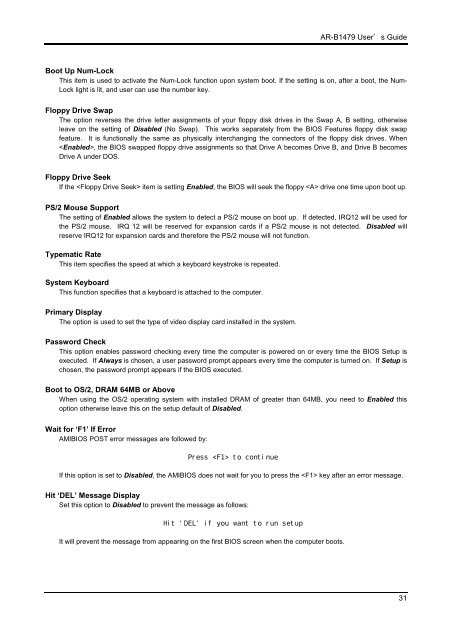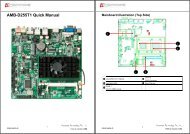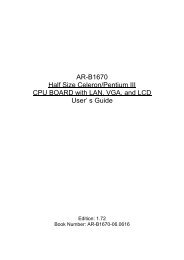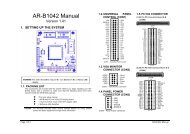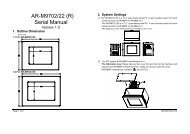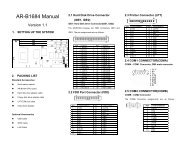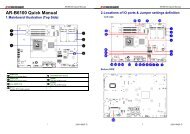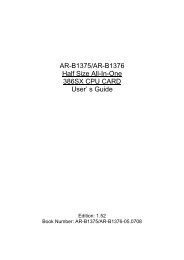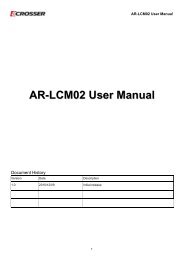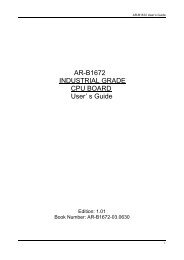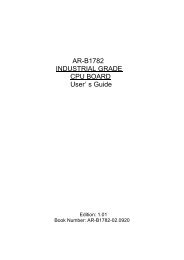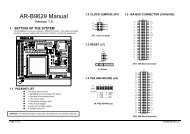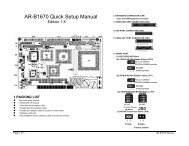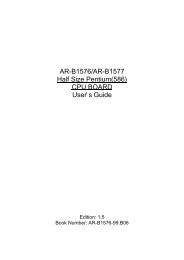INDUSTRIAL GRADE CPU BOARD User’ s Guide
AR-B1479 INDUSTRIAL GRADE CPU BOARD User' s ... - Acrosser
AR-B1479 INDUSTRIAL GRADE CPU BOARD User' s ... - Acrosser
Create successful ePaper yourself
Turn your PDF publications into a flip-book with our unique Google optimized e-Paper software.
AR-B1479 <strong>User’</strong>s <strong>Guide</strong><br />
Boot Up Num-Lock<br />
This item is used to activate the Num-Lock function upon system boot. If the setting is on, after a boot, the Num-<br />
Lock light is lit, and user can use the number key.<br />
Floppy Drive Swap<br />
The option reverses the drive letter assignments of your floppy disk drives in the Swap A, B setting, otherwise<br />
leave on the setting of Disabled (No Swap). This works separately from the BIOS Features floppy disk swap<br />
feature. It is functionally the same as physically interchanging the connectors of the floppy disk drives. When<br />
, the BIOS swapped floppy drive assignments so that Drive A becomes Drive B, and Drive B becomes<br />
Drive A under DOS.<br />
Floppy Drive Seek<br />
If the item is setting Enabled, the BIOS will seek the floppy drive one time upon boot up.<br />
PS/2 Mouse Support<br />
The setting of Enabled allows the system to detect a PS/2 mouse on boot up. If detected, IRQ12 will be used for<br />
the PS/2 mouse. IRQ 12 will be reserved for expansion cards if a PS/2 mouse is not detected. Disabled will<br />
reserve IRQ12 for expansion cards and therefore the PS/2 mouse will not function.<br />
Typematic Rate<br />
This item specifies the speed at which a keyboard keystroke is repeated.<br />
System Keyboard<br />
This function specifies that a keyboard is attached to the computer.<br />
Primary Display<br />
The option is used to set the type of video display card installed in the system.<br />
Password Check<br />
This option enables password checking every time the computer is powered on or every time the BIOS Setup is<br />
executed. If Always is chosen, a user password prompt appears every time the computer is turned on. If Setup is<br />
chosen, the password prompt appears if the BIOS executed.<br />
Boot to OS/2, DRAM 64MB or Above<br />
When using the OS/2 operating system with installed DRAM of greater than 64MB, you need to Enabled this<br />
option otherwise leave this on the setup default of Disabled.<br />
Wait for ‘F1’ If Error<br />
AMIBIOS POST error messages are followed by:<br />
Press to continue<br />
If this option is set to Disabled, the AMIBIOS does not wait for you to press the key after an error message.<br />
Hit ‘DEL’ Message Display<br />
Set this option to Disabled to prevent the message as follows:<br />
Hit ‘DEL’ if you want to run setup<br />
It will prevent the message from appearing on the first BIOS screen when the computer boots.<br />
31


